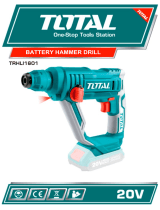
8
ENGLISH
non-skid safety shoes, hard hat, or hearing protection used
for appropriate conditions will reduce personalinjuries.
c ) Prevent unintentional starting. Ensure the switch
is in the off position before connecting to power
source and/or battery pack, picking up or carrying
the tool. Carrying power tools with your finger on the
switch or energising power tools that have the switch on
invitesaccidents.
d ) Remove any adjusting key or wrench before turning
the power tool on. A wrench or a key left attached
to a rotating part of the power tool may result in
personalinjury.
e ) Do not overreach. Keep proper footing and balance
at all times. This enables better control of the power tool
in unexpectedsituations.
f ) Dress properly. Do not wear loose clothing or
jewellery. Keep your hair, clothing and gloves away
from moving parts. Loose clothes, jewellery or long hair
can be caught in movingparts.
g ) If devices are provided for the connection of dust
extraction and collection facilities, ensure these are
connected and properly used. Use of dust collection
can reduce dust-relatedhazards.
4) Power tool use and care
a ) Do not force the power tool. Use the correct power
tool for your application. The correct power tool
will do the job better and safer at the rate for which it
wasdesigned.
b ) Do not use the power tool if the switch does not turn
it on and off. Any power tool that cannot be controlled
with the switch is dangerous and must berepaired.
c ) Disconnect the plug from the power source and/or
the battery pack from the power tool before making
any adjustments, changing accessories, or storing
power tools. Such preventive safety measures reduce the
risk of starting the power toolaccidentally.
d ) Store idle power tools out of the reach of children
and do not allow persons unfamiliar with the power
tool or these instructions to operate the power tool.
Power tools are dangerous in the hands of untrainedusers.
e ) Maintain power tools. Check for misalignment or
binding of moving parts, breakage of parts and any
other condition that may affect the power tool’s
operation. If damaged, have the power tool repaired
before use. Many accidents are caused by poorly
maintained powertools.
f ) Keep cutting tools sharp and clean. Properly
maintained cutting tools with sharp cutting edges are less
likely to bind and are easier tocontrol.
g ) Use the power tool, accessories and tool bits etc.,
in accordance with these instructions taking into
account the working conditions and the work to be
performed. Use of the power tool for operations different
from those intended could result in a hazardoussituation.
5) Service
a ) Have your power tool serviced by a qualified repair
person using only identical replacement parts. This
will ensure that the safety of the power tool ismaintained.
Additional Specific Safety Rules for Rotary
Hammers
• Wear ear protectors. Exposure to noise can cause
hearingloss.
• Use auxiliary handles supplied with the tool. Loss of
control can cause personalinjury.
• Hold power tools by insulated gripping surfaces when
performing an operation where the cutting tool may
contact hidden wiring or its own cord. Contact with a
“live” wire will make exposed metal parts of the tool “live” and
shock theoperator.
• Use clamps or other practical way to secure and support
the workpiece to a stable platform. Holding the work by
hand or against your body is unstable and may lead to loss
ofcontrol.
• Wear safety goggles or other eye protection. Hammering
operations cause chips to fly. Flying particles can cause
permanent eye damage. Wear a dust mask or respirator
for applications that generate dust. Ear protection may be
required for mostapplications.
• Keep a firm grip on the tool at all times. Do not attempt
to operate this tool without holding it with both hands.
It is recommended that the side handle be used at all times.
Operating this tool with one hand will result in loss of control.
Breaking through or encountering hard materials such as
re-bar may be hazardous as well. Tighten the side handle
securely beforeuse.
• Do not operate this tool for long periods of time.
Vibration caused by hammer action may be harmful to your
hands and arms. Use gloves to provide extra cushion and limit
exposure by taking frequent restperiods.
• Do not recondition bits yourself. Chisel reconditioning
should be done by an authorized specialist. Improperly
reconditioned chisels could causeinjury.
• Wear gloves when operating tool or changing bits.
Accessible metal parts on the tool and bits may get extremely
hot during operation. Small bits of broken material may
damage barehands.
• Never lay the tool down until the bit has come to a
complete stop. Moving bits could causeinjury.
• Do not strike jammed bits with a hammer to dislodge
them. Fragments of metal or material chips could dislodge
and causeinjury.
• Slightly worn chisels can be resharpened bygrinding.
• Keep the power cord away from the rotating bit. Do not
wrap the cord around any part of your body. An electric
cord wrapped around a spinning bit may cause personal
injury and loss ofcontrol.
WARNING: We recommend the use of a residual current
device with a residual current rating of 30mA or less.








